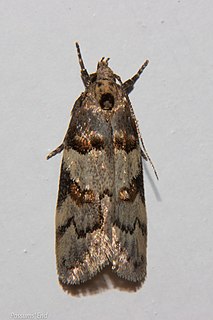Argidava is a genus of moths in the family Geometridae erected by Francis Walker in 1863.
Dichomeris permundella is a moth in the family Gelechiidae. It was described by Francis Walker in 1864. It is found in Peru and Amazonas, Brazil.
Compsolechia solidella is a moth of the family Gelechiidae. It was described by Francis Walker in 1864. It is found in Amazonas, Brazil.
Anacampsis conclusella is a moth of the family Gelechiidae. It was described by Francis Walker in 1864. It is found in North America, where it has been recorded from Alabama, Alberta, Florida, Illinois, Indiana, Kentucky, Louisiana, Maine, Maryland, Mississippi, New York, North Carolina, Ohio, Oklahoma, Pennsylvania, South Carolina, Tennessee, Texas and West Virginia.
Autosticha strenuella is a moth in the family Autostichidae. It was described by Francis Walker in 1864. It is found in Sri Lanka.
Anadasmus is a genus of moths in the subfamily Stenomatinae.
Lecithocera dissonella is a moth in the family Lecithoceridae. It was described by Francis Walker in 1864. It is found on Borneo.
Lichenaula afflictella is a moth in the family Xyloryctidae. It was described by Francis Walker in 1864. It is found in Australia, where it has been recorded from Queensland.
Pedois tripunctella is a moth in the family Depressariidae. It was described by Francis Walker in 1864. It is found in Australia, where it has been recorded from Tasmania.
Agriophara murinella is a moth in the family Depressariidae. It was described by Francis Walker in 1864. It is found in Australia.
Anadasmus quadratella is a moth in the family Depressariidae. It was described by Francis Walker in 1864. It is found in Panama, Suriname and Colombia.
Anadasmus venosella is a moth in the family Depressariidae. It was described by Francis Walker in 1864. It is found in Amazonas in Brazil and in Bolivia.
Antaeotricha adjunctella is a moth in the family Depressariidae. It was described by Francis Walker in 1864. It is found in Amazonas in Brazil and in the Guianas.
Antaeotricha mundella is a moth in the family Depressariidae. It was described by Francis Walker in 1864. It is found in Amazonas, Brazil.
Antaeotricha umbriferella is a moth in the family Depressariidae. It was described by Francis Walker in 1864. It is found in Amazonas, Brazil.
Cerconota armiferella is a moth in the family Depressariidae. It was described by Francis Walker in 1864. It is found in Amazonas, Brazil.
Stenoma ovatella is a moth in the family Depressariidae. It was described by Francis Walker in 1864. It is found in Brazil (Amazonas) and Colombia.
Stenoma straminella is a moth in the family Depressariidae. It was described by Francis Walker in 1864. It is found in Amazonas, Brazil.
Stenoma subnotatella is a moth in the family Depressariidae. It was described by Francis Walker in 1864. It is found in Ega, Brazil.

Trachypepla contritella, the Kiwi Enigma, is a species of moth in the family Oecophoridae. Originally endemic to New Zealand this species can be found throughout that country. However, from 2012 this species has been also been recorded in the United Kingdom. The preferred habitat of T. conritella is New Zealand native forest and larvae of this species are litter leaf feeders. Adults are on the wing from November to February in New Zealand and are attracted to light.
